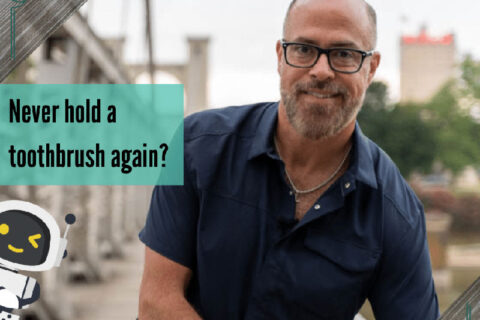A Whole New Level

How much time have you spent thinking about the different kinds of bacteria in your mouth? Odds are, not much. But did you know the mouth contains more than 700 types of bacteria — both good and bad? Might be worth giving it some thought after all!
These different bacteria strains are almost always present, some of them waiting to help digest food while others are waiting to get to work to cause tooth decay and gum disease — even right after you brush or visit the dentist for your professional dental cleanings (which you should be doing at least twice a year)!
These bacteria live in the sticky biofilm of dental plaque that stretches over the teeth and other tissues of your mouth. They feed off the sugar you eat — either from sweet treats or other carbohydrates — and the food debris left behind when you don’t brush or floss.
Some of these 700 bacteria also produce acids that erode your tooth enamel, cause cavities, and infect and inflame your gums.
So what can be done about battling harmful bacteria?
A new research study may have the answer. The study has found a way to stop these persistent bacteria in their tracks without killing them, which means putting a stop to plaque and cavities.
The study, conducted by the University of Chicago and presented at the American Chemical Society’s Fall 2020 Virtual Meeting & Expo, highlighted the use of a new type of cerium nanoparticle formulation applied to the teeth while you’re at the dentist’s office for your regular checkup.
Traditionally, dentists battled bacteria using products that contain stannous fluoride, as well as silver nitrate or silver diamine fluoride dental restorations, to slow down the development of dental plaque and stop existing tooth decay from worsening.
Other research studies have shown success in using nanoparticles made of zinc oxide, copper oxide or silver to treat dental infections. Some studies have shown the benefits of using bactericidal agents to help treat overgrowths of oral bacteria. But using these agents too frequently can lead to both stained teeth and bacterial resistance, as they kill many types of bacteria in your mouth — including good ones.
Researchers set out to find a way to reduce the levels of illness- and decay-causing bacteria in the mouth without wiping out good bacteria; they also wanted to prevent cavities versus just treating them.
The team turned to cerium oxide nanoparticles as a potential solution. Previous research has shown the value of different types of cerium oxide nanoparticles in combating bacterial infections. Still, only a few researchers have examined their effects on the bacteria in dental plaque. The ones who did prepared their nanoparticles using oxidation-reduction reactions or pH-driven precipitation reactions. Some also bought nanoparticles from commercial sources.
None of these earlier studies showed success in the lab.
Wanting to use a different approach to preparing the nanoparticles, the Chicago researchers produced their nanoparticles using dissolved ceric ammonium nitrate or sulfate salts in water.
The researchers then seeded polystyrene plates with Streptococcus mutans, a bacteria known to cause gum disease and tooth decay, in growth media. They fed the bacteria sugar in the cerium oxide nanoparticle solution and found that the formulation reduced biofilm growth by 40 percent compared to control plates that did not have the nanoparticles.
However, despite the adjustment, the researchers were not able to dislodge existing plaque.
In the nanoparticle solution, adding silver nitrate, a substance known to fight cavities, also did not affect dental plaque growth.
So, while the study did not result in killing off harmful bacteria, it still was, in part, a success because the bacteria were neutralized.
The nanoparticles worked to prevent the bacteria that cause tooth decay and gum disease from sticking to some surfaces and developing into plaque.
The study also noted that the nanoparticles were less toxic and had fewer metabolic effects on human oral cells in Petri dishes than silver nitrate.
So, the future of protecting your oral health may be found in tiny nanoparticles!
The researchers on the study have plans to combine the nanoparticles with enamel-strengthening fluoride that can be painted on your teeth at dental visits, but that project is a long way off.
In the meantime, they’re working on developing special coatings to help stabilize the nanoparticles to be more similar to the saliva’s pH, which will be better for the teeth because it will be less acidic.
While you’re waiting on this study to come to fruition, we still recommend that you brush at least twice per day, floss at least once per day and visit us at least twice a year to maintain good oral health.
If you need to schedule a checkup, call us now at 254-799-9540 today.


